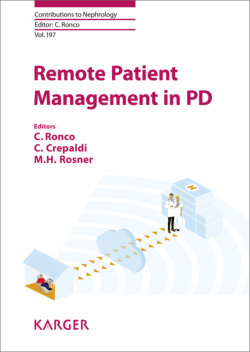Читать книгу Remote Patient Management in Peritoneal Dialysis - Группа авторов - Страница 24
На сайте Литреса книга снята с продажи.
Evolution of Cyclers
ОглавлениеA renewed interest in APD occurred in the early 1980s when Diaz e Buzo described a new treatment schedule called continuous cyclic PD. The technique was performed through a simplified machine able to operate 3 exchanges during nighttime and one during daytime, with a schedule opposite to CAPD [5].
At the end of 1980s, cyclers underwent progressive improvement in terms of hardware components and layout, making APD safer, quieter, and less bulky. This is the case of Pac-X and its upgraded version Pac-XTRA produced by Baxter, PCS 2000 by Fresenius and PD 100 T from Gambro. This generation of cyclers utilized disposable materials and allowed individualization of dialysis by personalized prescription of intraperitoneal volume and dwell time. These machines allowed to perform different APD treatment schedules such as intermittent PD, nightly intermittent PD, continuous cyclic PD, and even tidal volume prescription (TPD).
Fig. 2. Evolution of PD cyclers from origin to today. PD, peritoneal dialysis; APD, automated PD.
A milestone occurred in 1994 when Baxter launched HOMECHOICE (Fig. 2). Thanks to improved hardware components, the new cycler was compact and portable, weighing only 12 kg. Moreover, the device abandoned the gravity control of flows using volumetric pumps and allowing higher accuracy of dialytic exchanges. The following version, the HOMECHOICE Pro, added a 2 Mb data card with 60 days of treatment storage capability. Memory cards revolutionized the way physicians and nurses manage therapy. Cards were permitted to program patient’s prescription and to record treatment details. By inserting a card into the slot, prescription was uploaded by the machine and treatment memorized. For the first time, home therapy could be verified by analyzing possible problem experiences during treatment by patients. At the same time, patient’s compliance and adherence to prescription could also be assessed. Data downloaded from the card during hospital visits were utilized to populate a data base containing important historical information on treatments and patients.
Other companies produced APD machine with similar features, such as the PD night equipment and its upgraded version, the Sleep Safe (FMC, Bad Homburg, Germany), the PD 100T, PD 101, PD 200 and Serena (Gambro, Lund, Sweden). The last version of all these machines presented similar features such as data recording (60–180 days of treatment), possibility to prescribe total dialysate volume, exchange fill volume, tidal percentage and time. Sleep Safe and Serena also allowed deciding the dwell time and number of cycles. Sleep Safe was equipped with a system for the automatic detection of the type of bag, avoiding possible mistakes in bag selection. It also allowed profiling glucose percentage at each cycle. All machines were permitted to use solutions of other companies through adaptors. They were different in the way they moved and measured fluid volumes. Pneumatic and hydraulic pumps were used by HOMECHOICE Pro and Sleep Safe, respectively, while Serena incorporated a pressure chamber. Both HOMECHOICE Pro and Sleep Safe used a volumetric system to measure fluids, while Serena used a gravity-based system. In addition, Serena also allowed prescription in breakpoint modality, varying the tidal percentage depending on the drainage flow rate: when the drainage flow started to become too slow (30–60 mL/min), a new fill cycle started, provided a pre-set cut off volume had been achieved. This modality optimized drainage and avoided spending too much time in the last part of the exchange to drain only 15–25% of the residual intraperitoneal volume.
All these cyclers were safe and accurate in delivering dialysis treatment. A built-in battery allowed to suspend treatment and memorize data in case of power breakdown. They were easy to use with a friendly user interface guiding the patient throughout the procedure, from therapy initiation to the final disconnection. With the evolution of information communication technology, cyclers were progressively equipped with specific software designed to individualize patient prescription based on personal data and treatment history. Last versions even included a section for simulation, based on mathematical models, of hypothetical adequacy targets obtained with different dialysis schedules in case of different peritoneal membrane characteristics [6, 7].
The most recent cyclers (HOMECHOICE CLARIA with the variants AMIA and KAGUYA, Baxter, Dirfield, IL, USA, and Sleep Safe Harmony, FMC, Bad Homburg, Germany) present significant innovation, mostly related to the software components (allowing new treatment schedules) and the bidirectional communication features (allowing true implementation of telemedicine and RPM).
Experimental studies were carried out to explore different areas of PD, including the possibility to perform continuous flow PD using a special double lumen catheter [8] and the potential development of wearable miniaturized cyclers for continuous wearable PD [9].
